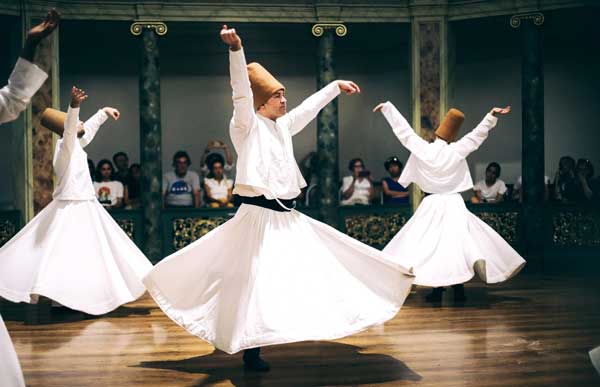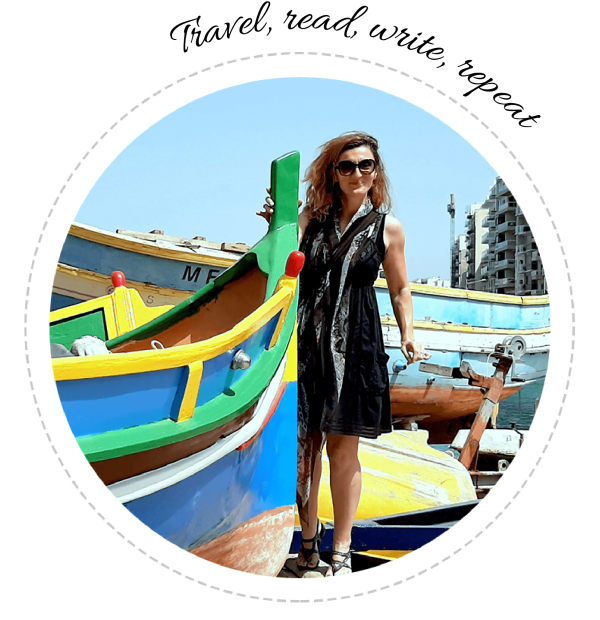
If you need a freelance travel writer or you would like to see your country, city, flight, etc., presented on the blog, drop me an email.
Find our more on Freelance Travel Writer page.
Although you have hours to go from the Antalya Riviera towards Cappadocia, fortunately, there are a few worthy stops along the way. It’s not just a chance to stretch your legs, but an opportunity to see and learn so much. And so, we are now entering the cradle of dervishes.

The town of Konya, Turkey, might not look very appealing from a distance, but is home to the famous Mevlana Museum and the Mausoleum of the Persian Sufi scholar Jalaluddin Rumi. You might know who the whirling dervishes are from their specific form of prayer. Dressed in long robes with tall hats on their heads, dervishes whirl for hours to reach a state of religious ecstasy. Their ritual dance is called Sema.
The Mevlevi Order was founded right here in Konya, Turkey, during the Seljuk Turks’ rule.

Besides Mevlana Rumi who founded the Mevlevi Order in the 12th century, another significant figure was Divani Mehmet Chelebi. The Chelebists, or “the kind ones,” who went out into the world to spread the teachings, were followers of this grandmaster.
Many monasteries, or Semahanes, of the Order were established worldwide under Mehmet Chelebi’s influence. There’s one in Aleppo, Syria, as well as in Egypt, Algeria, and on the Greek islands of Chios and Mytilene. The famous Galata Mevlevihane in Istanbul was one of the religious structures erected in a later period.
A Mevlevihane is a kind of monastery consisting of dervishes’ premises, a museum, and a prayer room. The ritual of Rumi’s followers is described as “an act of love and a drama of faith.”.

The ritual consists of precisely coordinated movements, with whirling that gradually increases from gentle and slow to dynamic and fast, leading to a state of religious trance. The music, in sync with the movements, changes rhythm and speed, giving a hypnotic effect to observers and helping the dervishes reach their state of ecstasy.
The Mevlevi Order is part of the Sunni mainstream of Islam. While it was sometimes criticized for heretical ideas, it still earned the respect of officials.
Some notable leaders who supported the Order were Ottoman Sultan Mehmed the Conqueror, who took over Constantinople, Sultan Selim III (who was also a member), and Suleyman the Magnificent, who built a Semahane in Konya Turkey as a gift from the court.
Rumi’s followers had a significant impact on the development of Ottoman culture, influencing poetry, calligraphy, and visual arts from the 14th to the 20th century. However, their greatest achievement was in music. While Islamic dogma generally forbids music as “damaging to listeners and religion,” dervishes incorporated it into their rituals through the Mevlud, a poem chanted in honor of the Prophet Mohammed.

They aimed to reach “the notes of Heaven” through their music. Being part of the order also became a way to study arts, music, and dance.
Sema includes 12 musicians playing traditional Turkish instruments and 12 dancers. According to the teachings, the essence of all beings – from atoms to the planets in the universe – is to revolve. Everything participates in this almighty revolving, and thus the Semazens, the ones who whirl, take part in this cosmic movement through their prayer.
The Sema ritual represents a spiritual journey and a path of self-transformation.
The dervishes’ clothes are rich in symbolism – the tall hat represents a tombstone, while the wide white robe symbolizes a funeral shroud. If you ever wondered who are the whirling dervishes, here are a few hints about the symbolism of their rituals.

The dance is equally symbolic. At the beginning of Sema, dervishes stand with their arms crossed, only to spread them later to form the number One, symbolizing God. One typical position is with the right arm extended toward the sky, “ready to receive God’s mercy,” while the left hand faces the ground in a giving gesture. As they whirl from right to left, the dervishes greet all of existence, repeating the name of God. The Sema is a prayer that, through seven stages, gradually brings believers closer to their God.

The Mevlana Museum in Konya still holds a mystical atmosphere, despite the crowds of tourists with colorful scarves and protective shoe covers, which are obligatory when entering. The Oriental surroundings allure from every corner of the building as you wait in line with curious visitors and Mevlana admirers.
If you would rather go around Konya accompanied by a guide which is a great idea given all the info you will hear along the way, click the link for an organized tour around the town and the Mevlana Museum. And enjoy your visit!
Next: IMAGINE A NIGHT IN CARAVANSERAI
The full Cappadocia SERIES
PIN IT FOR LATER:
If you need a freelance travel writer or you would like to see your country, city, flight, etc., presented on the blog, drop me an email.
Find our more on Freelance Travel Writer page.
I am looking forward to working with you.




4 responses
Wonderful! A lot of information is shared. Thank you… On December 17 every year, one may have a chance to watch whirling dervishes at the activity called ‘Seb-i Arus’ (at the Mevlana Mausoleum in Konya). ‘Şeb-i Arus’ (which is not Turkish) means ‘the Wedding Day’. Actually, what is celebrated is Mevlana’s death, so his reunion with his Beloved, with the Divine.
Thanks, just a perfect information, the one that was missing! 🙂
Very beautiful description of the Mevlud! An “enchanted poem” has encouraged me to learn more!
The whole thing is more then interesting when you dig a bit deeper. So glad it was inspirational, thanks. 🙂